brake TOYOTA TACOMA 2013 Owners Manual (in English)
[x] Cancel search | Manufacturer: TOYOTA, Model Year: 2013, Model line: TACOMA, Model: TOYOTA TACOMA 2013Pages: 524, PDF Size: 10.96 MB
Page 2 of 524

TABLE OF CONTENTSIndex
2
1-1. Key informationKeys ..................................... 32
1-2. Opening, closing and locking the doors
Wireless remote control ....... 34
Side doors ............................ 37
Access doors (Access Cab models only) ....................... 41
Tailgate ................................ 42
1-3. Adjustable components (seats, mirrors, steering
wheel)
Front seats ........................... 47
Rear seats (Access Cab and Double Cab models) .......... 52
Head restraints ..................... 56
Seat belts ............................. 61
Steering wheel ..................... 67
Anti-glare inside rear view mirror .................................. 68
Outside rear view mirrors ..... 73
1-4. Opening and closing the windows
Power windows .................... 76
Back window (vehicles with sliding type) ........................ 78
1-5. Refueling Opening the fuel tank cap .... 79 1-6. Theft deterrent system
Engine immobilizer system ... 82
1-7. Safety information Correct driving posture ......... 85
SRS airbags ......................... 87
Front passenger occupant classification system ......... 101
Child restraint systems ....... 106
Installing child restraints ..... 110
2-1. Driving procedures Driving the vehicle .............. 130
Engine (ignition) switch....... 141
Automatic transmission ...... 144
Manual transmission........... 148
Turn signal lever ................. 151
Parking brake ..................... 152
Horn .................................... 154
2-2. Gauges and meters Gauges and meters ............ 155
Indicators and warning lights ................................. 158
2-3. Operating the lights and wipers
Headlight switch ................. 162
Fog light switch ................... 165
Windshield wipers and washer .............................. 166
1Before driving
2When driving
Page 19 of 524
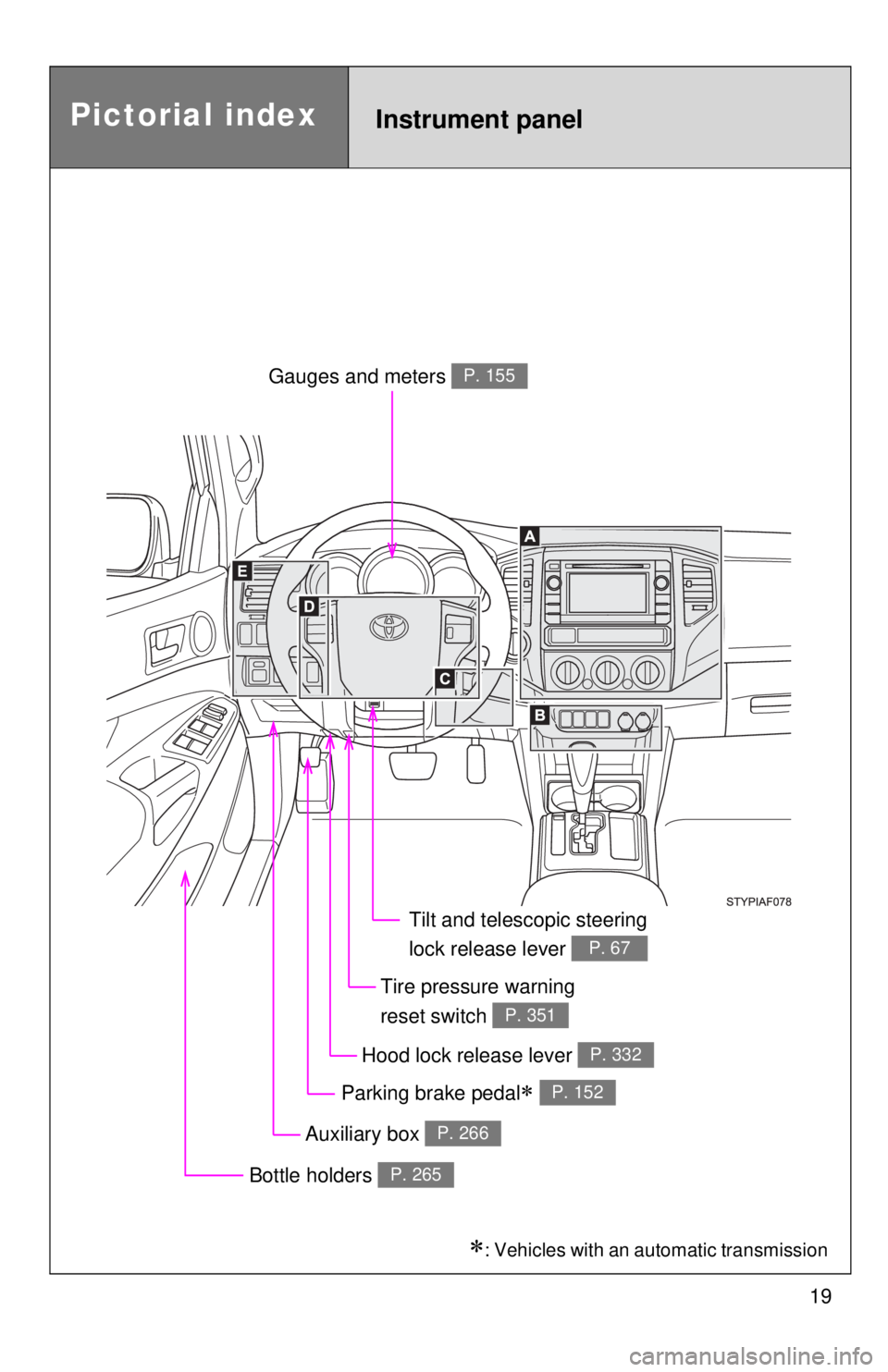
19
Pictorial indexInstrument panel
Auxiliary box P. 266
Gauges and meters P. 155
Hood lock release lever P. 332
Tilt and telescopic steering
lock release lever
P. 67
Bottle holders P. 265
Parking brake pedal P. 152
Tire pressure warning
reset switch
P. 351
: Vehicles with an automatic transmission
Page 21 of 524
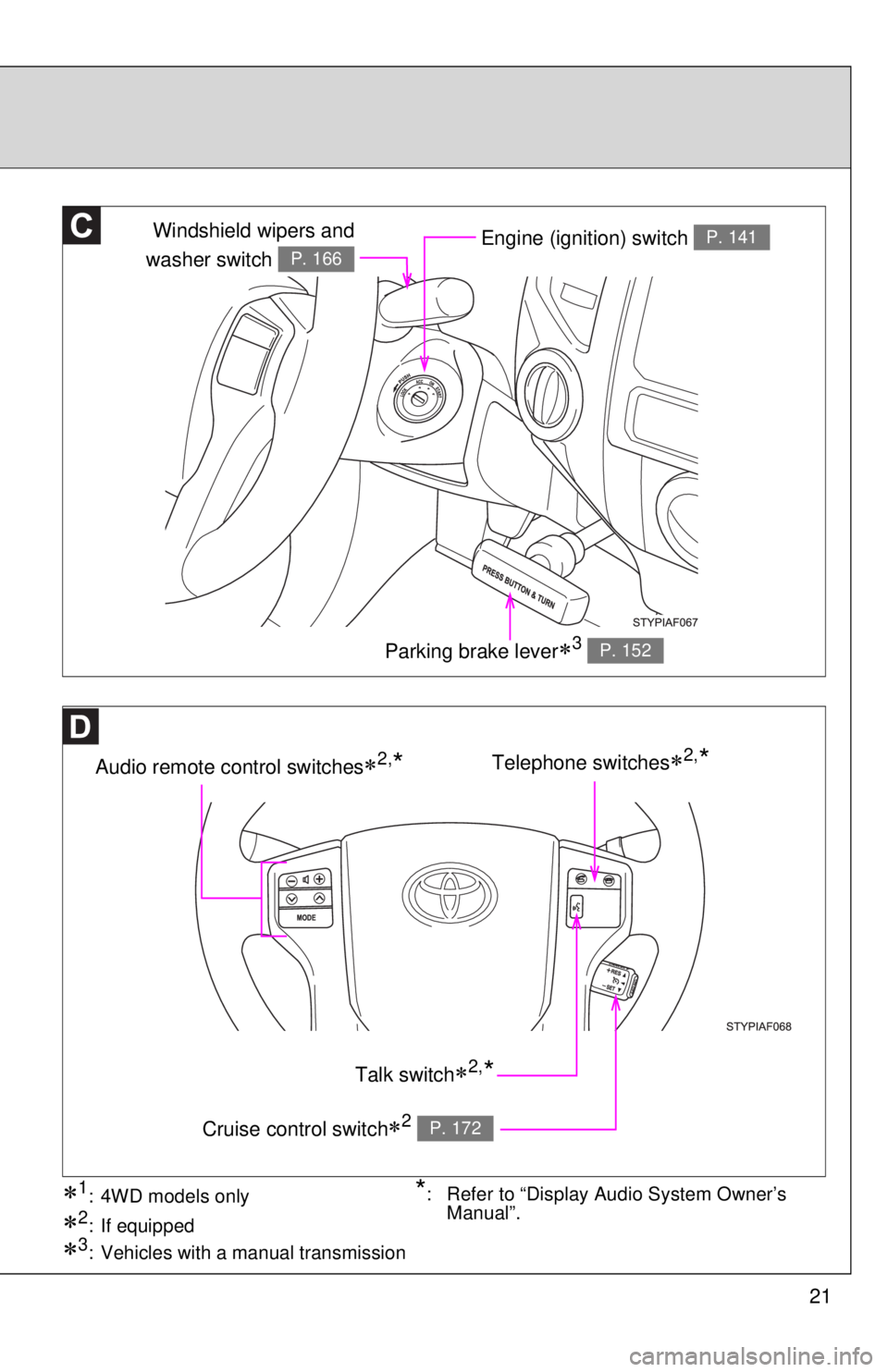
21
Engine (ignition) switch P. 141
Audio remote control switches2,*
Windshield wipers and
washer switch
P. 166
Parking brake lever3 P. 152
Telephone switches2,*
Talk switch2,*
Cruise control switch2 P. 172
3: Vehicles with a manual transmission
1: 4WD models only
2: If equipped
*: Refer to “Display Audio System Owner’s Manual”.
Page 26 of 524

26
Installation of a mobile two-way radio system
The installation of a mobile two-way radio system in your vehicle could affect
electronic systems such as:
●Multiport fuel injection system/sequential multiport fuel injection system
● Cruise control system
● Anti-lock brake system
● SRS airbag system
● Seat belt pretensioner system
Be sure to check with your Toyota dealer for precautionary measures or spe-
cial instructions regarding installation of a mobile two-way radio system.
Vehicle data recordings
Your Toyota is equipped with several sophisticated computers that will record
certain data, such as:
• Engine speed
• Accelerator status
• Brake status
• Vehicle speed
• Shift position (except manual transmission)
The recorded data varies according to the vehicle grade level and options
with which it is equipped. Furthermore, these computers do not record con-
versations, sounds or pictures.
● Data usage
Toyota may use the data recorded in these computers to diagnose malfunc-
tions, conduct research and development, and improve quality.
Toyota will not disclose the recorded data to a third party except:
• With the consent of the vehicle owner or with the consent of the lessee if the vehicle is leased
• In response to an official request by the police, a court of law or a govern-
ment agency
• For research purposes where the data is not tied to a specific vehicle or vehicle owner
Page 27 of 524

27
Event data recorder
This vehicle is equipped with an event data recorder (EDR). The main pur-
pose of an EDR is to record, in certain crash or near crash-like situations,
such as an air bag deployment or hitting a road obstacle, data that will assist
in understanding how a vehicle’s systems performed. The EDR is designed
to record data related to vehicle dynamics and safety systems for a short
period of time, typically 30 seconds or less.
The EDR in this vehicle is designed to record such data as:
• How various systems in your vehicle were operating;
• Whether or not the driver and passenger safety belts were buckled/fas-tened;
• How far (if at all) the driver was depressing the accelerator and/or brake pedal; and,
• How fast the vehicle was traveling.
These data can help provide a better understanding of the circumstances in
which crashes and injuries occur.
NOTE: EDR data are recorded by your vehicle only if a non-trivial crash situ-
ation occurs; no data are recorded by the EDR under normal driving condi-
tions and no personal data (e.g., name, gender, age, and crash location) are
recorded. However, other parties, such as law enforcement, could combine
the EDR data with the type of personally identifying data routinely acquired
during a crash investigation.
To read data recorded by an EDR, special equipment is required, and access
to the vehicle or the EDR is needed. In addition to the vehicle manufacturer,
other parties, such as law enforcement, that have the special equipment, can
read the information if they have access to the vehicle or the EDR.
Page 129 of 524
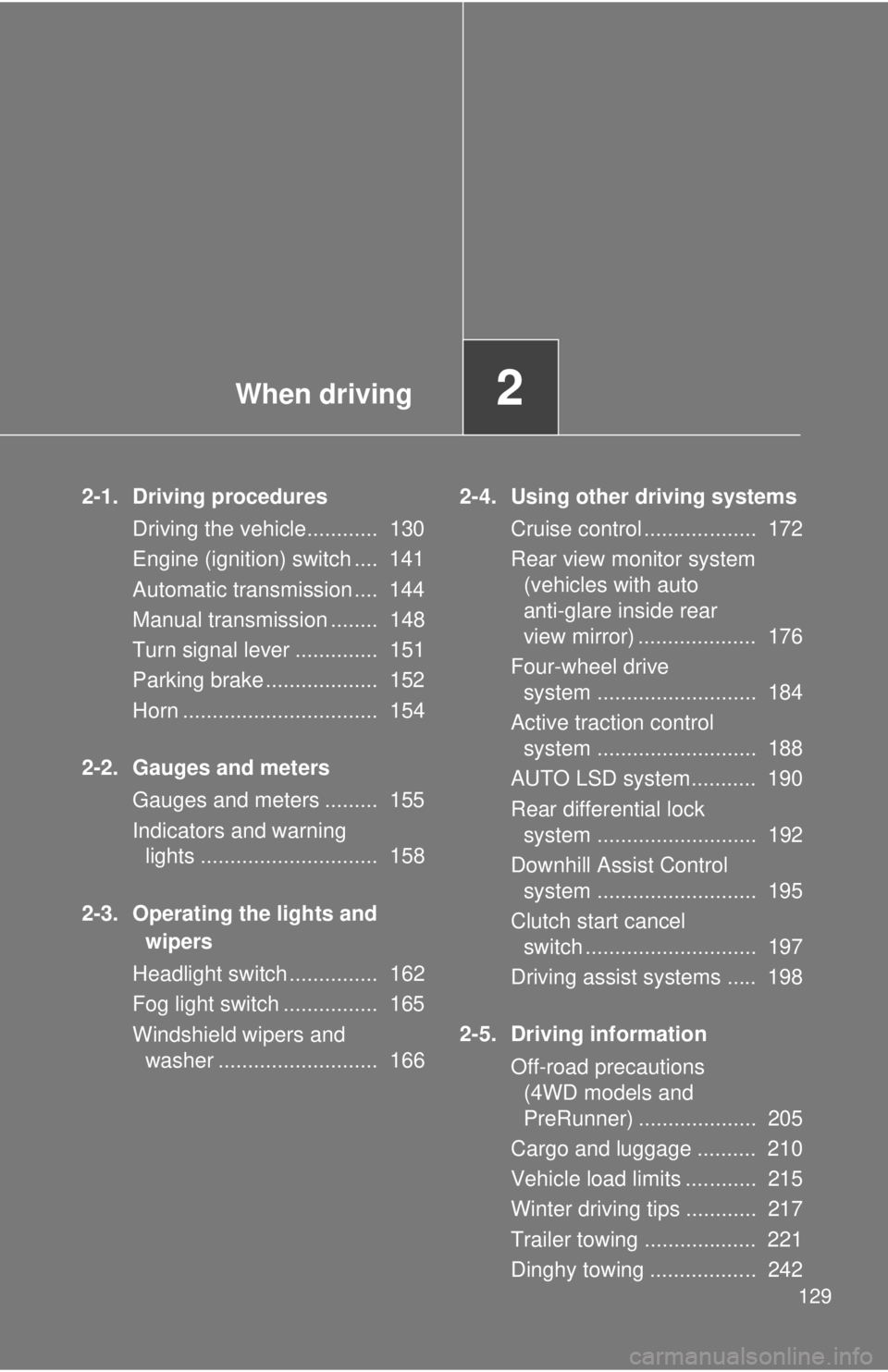
When driving2
129
2-1. Driving proceduresDriving the vehicle............ 130
Engine (ignition) switch .... 141
Automatic transmission .... 144
Manual transmission ........ 148
Turn signal lever .............. 151
Parking brake ................... 152
Horn ................................. 154
2-2. Gauges and meters Gauges and meters ......... 155
Indicators and warning lights .............................. 158
2-3. Operating the lights and wipers
Headlight switch ............... 162
Fog light switch ................ 165
Windshield wipers and washer ........................... 166 2-4. Using other driving systems
Cruise control ................... 172
Rear view monitor system (vehicles with auto
anti-glare inside rear
view mirror) .................... 176
Four-wheel drive system ........................... 184
Active traction control system ........................... 188
AUTO LSD system........... 190
Rear differential lock system ........................... 192
Downhill Assist Control system ........................... 195
Clutch start cancel switch ............................. 197
Driving assist systems ..... 198
2-5. Driving information Off-road precautions (4WD models and
PreRunner) .................... 205
Cargo and luggage .......... 210
Vehicle load limits ............ 215
Winter driving tips ............ 217
Trailer towing ................... 221
Dinghy towing .................. 242
Page 130 of 524
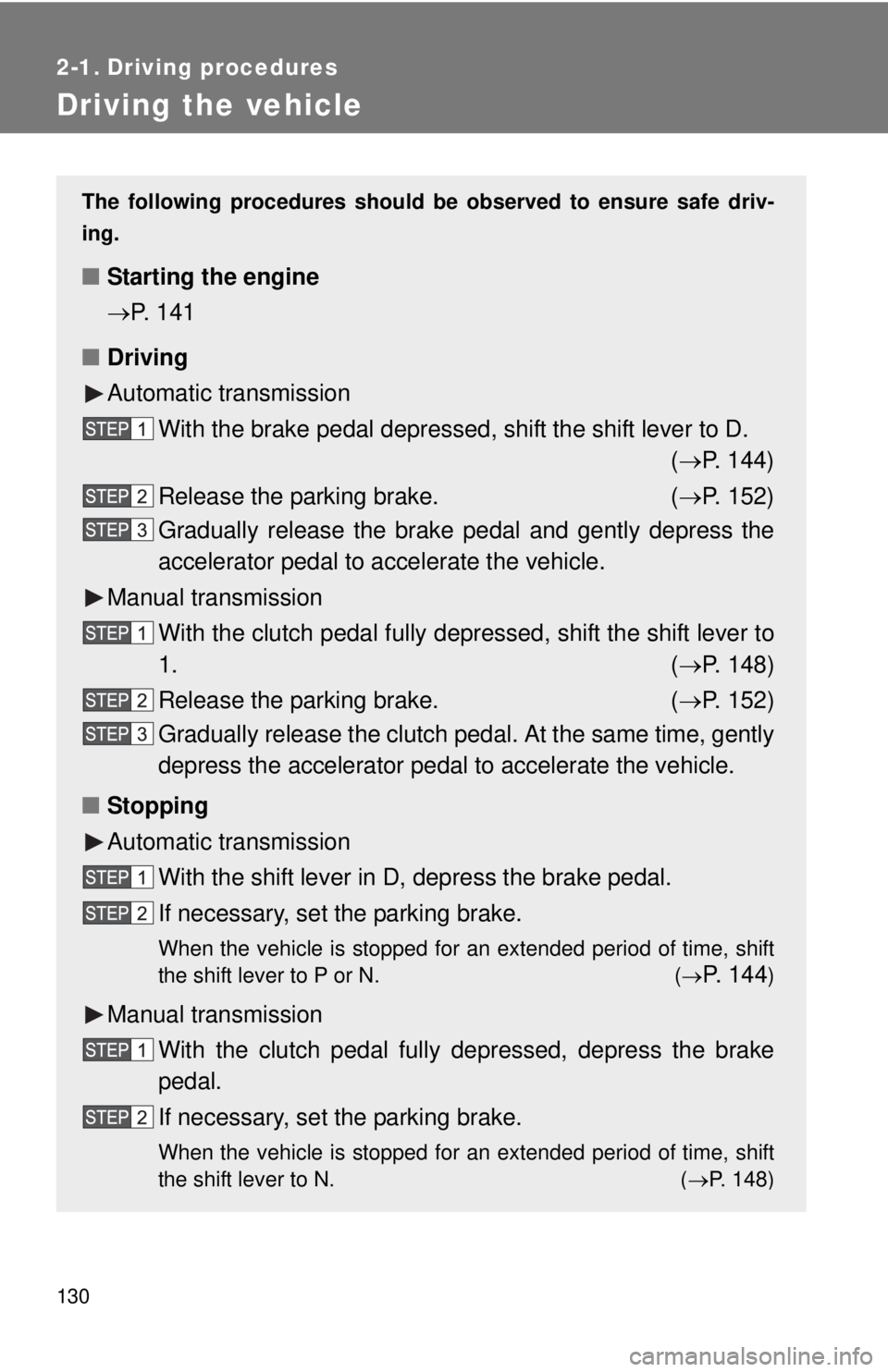
130
2-1. Driving procedures
Driving the vehicle
The following procedures should be observed to ensure safe driv-
ing.
■ Starting the engine
P. 141
■ Driving
Automatic transmission
With the brake pedal depressed, shift the shift lever to D. ( P. 144)
Release the parking brake. ( P. 152)
Gradually release the brake pedal and gently depress the
accelerator pedal to accelerate the vehicle.
Manual transmission With the clutch pedal fully depressed, shift the shift lever to
1. ( P. 148)
Release the parking brake. ( P. 152)
Gradually release the clutch pedal. At the same time, gently
depress the accelerator pedal to accelerate the vehicle.
■ Stopping
Automatic transmission
With the shift lever in D, depress the brake pedal.
If necessary, set the parking brake.
When the vehicle is stopped for an extended period of time, shift
the shift lever to P or N. (
P. 1 4 4)
Manual transmission
With the clutch pedal fully depressed, depress the brake
pedal.
If necessary, set the parking brake.
When the vehicle is stopped for an extended period of time, shift
the shift lever to N. ( P. 148)
Page 131 of 524
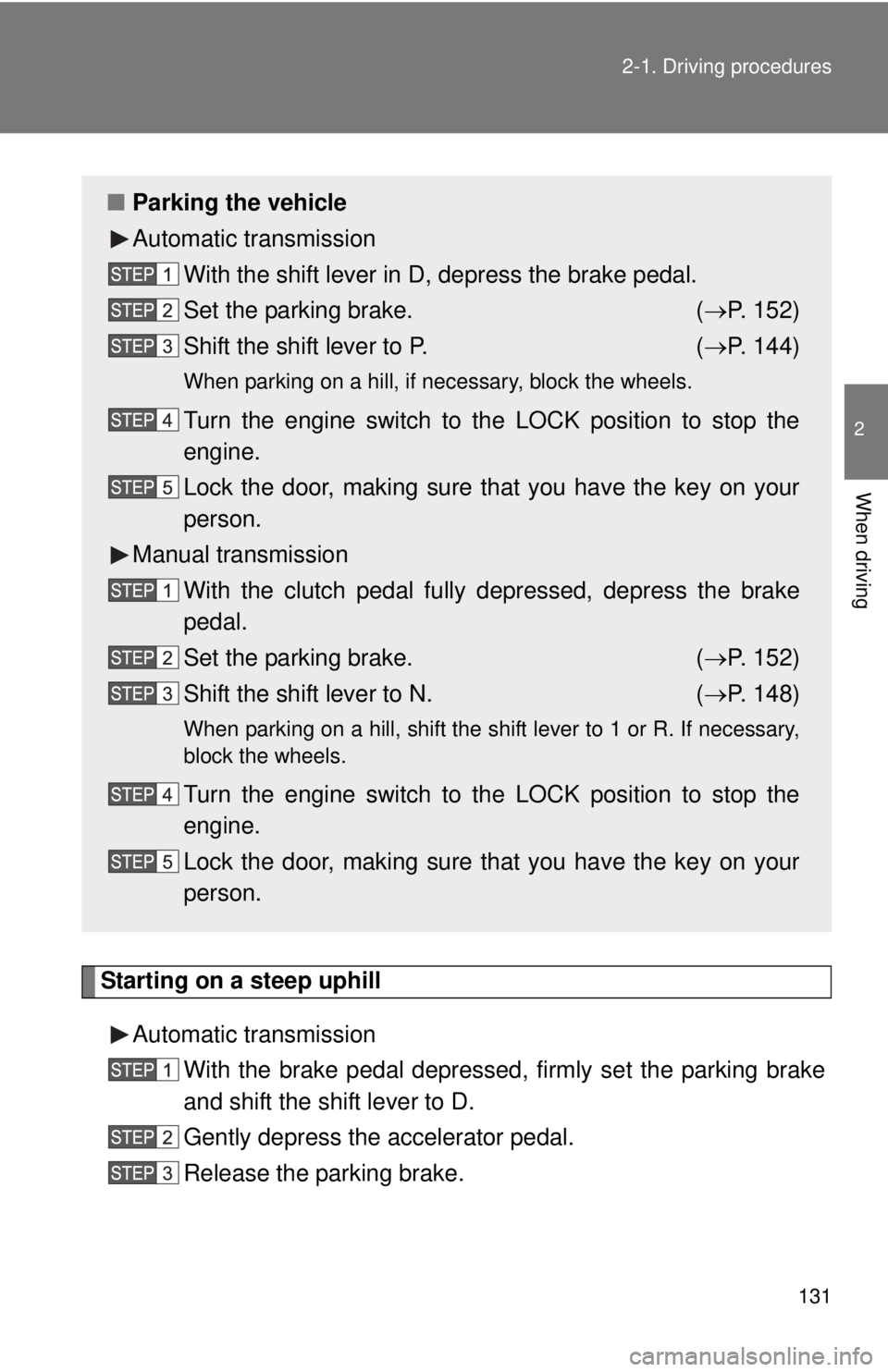
131
2-1. Driving procedures
2
When driving
Starting on a steep uphill
Automatic transmission With the brake pedal depressed, firmly set the parking brake
and shift the shift lever to D.
Gently depress the accelerator pedal.
Release the parking brake.
■Parking the vehicle
Automatic transmission
With the shift lever in D, depress the brake pedal.
Set the parking brake. ( P. 152)
Shift the shift lever to P. ( P. 144)
When parking on a hill, if necessary, block the wheels.
Turn the engine switch to the LOCK position to stop the
engine.
Lock the door, making sure that you have the key on your
person.
Manual transmission With the clutch pedal fully depressed, depress the brake
pedal.
Set the parking brake. ( P. 152)
Shift the shift lever to N. ( P. 148)
When parking on a hill, shift the shift lever to 1 or R. If necessary,
block the wheels.
Turn the engine switch to the LOCK position to stop the
engine.
Lock the door, making sure that you have the key on your
person.
Page 132 of 524

132 2-1. Driving procedures
Manual transmissionWith the parking brake firmly set and the clutch pedal fully
depressed, shift the shift lever to 1.
Lightly depress the accelerator pedal at the same time as
gradually releasing the clutch pedal.
Release the parking brake.
■Driving in the rain
●Drive carefully when it is raining, because visibility will be reduced, the
windows may become fogged-up, and the road will be slippery.
● Drive carefully when it starts to rain, because the road surface will be
especially slippery.
● Refrain from high speeds when driving on an expressway in the rain,
because there may be a layer of water between the tires and the road
surface, preventing the steering and brakes from operating properly.
■ Breaking in your new Toyota
To extend the life of the vehicle, the following precautions are recommended
to observe:
●For the first 200 miles (300 km):
Avoid sudden stops.
● For the first 500 miles (800 km):
Do not tow a trailer.
● For the first 1000 miles (1600 km):
• Do not drive at extremely high speeds.
• Avoid sudden acceleration.
• Do not drive continuously in the low gears.
• Do not drive slowly with the manual transmission in a high gear.
• Do not drive at a constant speed for extended periods.
■ Operating your vehicle in a foreign country
Comply with the relevant vehicle registration laws and confirm the availability
of the correct fuel. ( P. 453)
Page 133 of 524

133
2-1. Driving procedures
2
When driving
CAUTION
■
When starting the vehicle (vehicl es with an automatic transmission)
Always keep your foot on the brake pedal while stopped with the engine run-
ning. This prevents the vehicle from creeping.
■ When driving the vehicle
●Do not drive if you are unfamiliar with the location of the brake and accel-
erator pedals to avoid depressing the wrong pedal.
• Accidentally depressing the accelerator pedal instead of the brake
pedal will result in sudden acceleration that may lead to an accident
that could result in death or serious injury.
• When backing up, you may twist your body around, leading to a diffi- culty in operating the pedals. Make sure to operate the pedals properly.
• Make sure to keep a correct driving posture even when moving the vehicle only slightly, allowing you to depress the brake and accelerator
pedals properly.
• Depress the brake pedal using your right foot. Depressing the brake pedal using your left foot may delay response in an emergency, result-
ing in an accident.
● Do not drive the vehicle over or st op the vehicle near flammable materials.
The exhaust system and exhaust gases can be extremely hot. This may
cause a fire if there is any flammable material nearby.
● On vehicles with an automatic transmission, do not let the vehicle roll
backwards while the shift lever is in a driving position, or roll forward while
the shift lever is in R.
Doing so may cause the engine to stall or lead to poor brake and steering
performance, resulting in an accident or damage to the vehicle.
● If the smell of exhaust is noticed inside the vehicle, open the windows and
check that the back window is closed. Large amounts of exhaust in the
vehicle can cause driver drowsiness and an accident, resulting in death or
a serious health hazard. Have the vehicle inspected by your Toyota dealer
immediately.
● On vehicles with an automatic transmission, do not shift the shift lever to P
while the vehicle is moving.
Doing so can damage the transmission and may result in a loss of vehicle\
control.